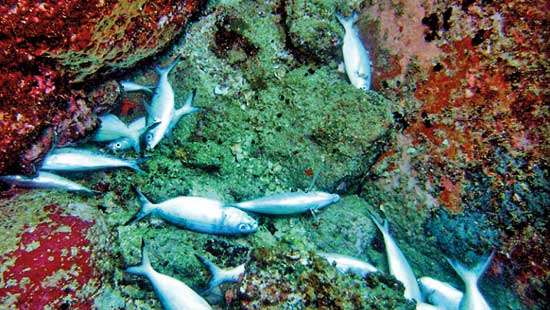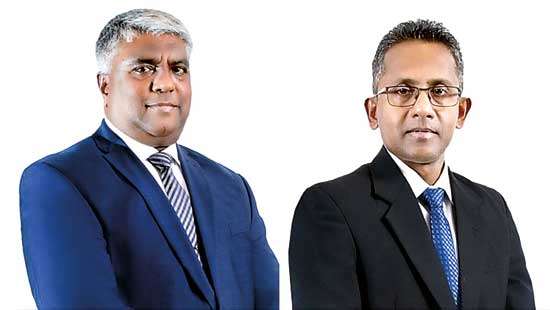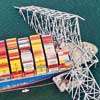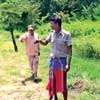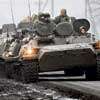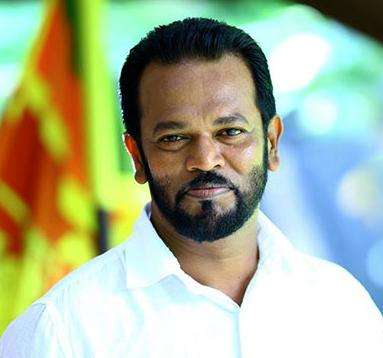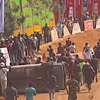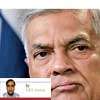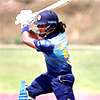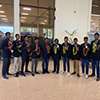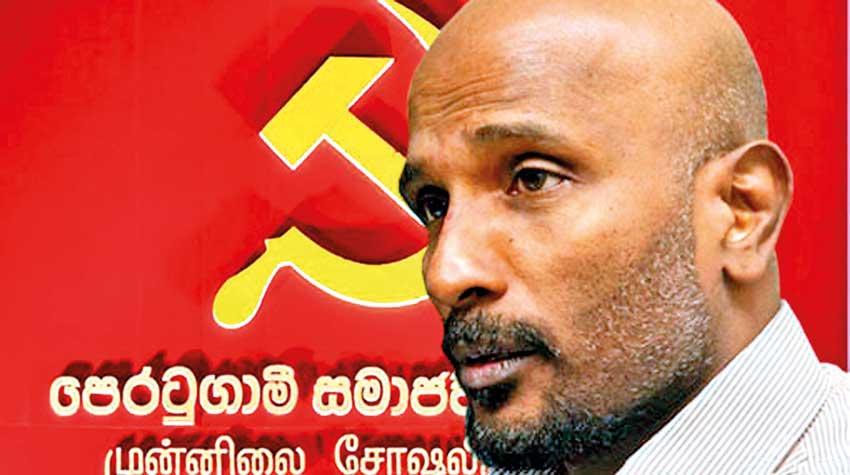
A remarkably significant outcome of the Aragalaya has been the emergence of the “Peratugami Samajavadi Pakshaya” (Frontline Socialist Party) as an influential player in Sri Lankan politics
The Peratugami Samajavadi Pakshaya is composed of the members who defected from the Janatha Vimukthi Peramuna (JVP). It can be considered as a party that was born in the political womb of the JVP and competes with it
The pioneering role played by the Anthar Vishwa Vidyalaya Shishya Bala Mandalaya (Inter-University Students’ Federation) which can be considered as the university student union of the party in preparing and mobilising militant student groups for the uprising seems to have contributed significantly to the enhancement of the strength of the Peratugami Samajavadi Party
By
D.B.S. Jeyaraj
“Gota Go Home” was the clarion call around which the people launched their “Aragalaya” or Struggle. It has achieved its primary goal. Gota has been made to go, but to which home remains an unanswered question still. It is also unclear as to whether he has indeed resigned as President. This column will celebrate when there is more light on these matters.
A remarkably significant outcome of the Aragalaya has been the emergence of the “Peratugami Samajavadi Pakshaya” (Frontline Socialist Party) as an influential player in Sri Lankan politics. The FSP along with its undergraduate front Inter-University Students’ Federation played key roles in the struggle. Veteran political journalist Victor Ivan opines that the FSP took control of the uprising and claimed ownership of the struggle. Here are relevant excerpts from Victor’s latest article “What could be the end of the revolution?” in the “Daily FT” of July 15, 2022.
Victor Ivan Article Excerpts
“Though this Aragalaya remained to a great extent, as a movement launched by a combination of a large number of youth groups which are independent of party politics, the Peratugami Samajavadi Pakshaya (Frontline Socialist Party) was able to seize control of the uprising and claim it as a struggle of their own at the last moment.”
“The Peratugami Samajavadi Pakshaya is composed of the members who defected from the Janatha Vimukthi Peramuna (JVP). It can be considered as a party that was born in the political womb of the JVP and competes with it. There was a competition between these two parties ever since the Peratugami Samajavadi Pakshaya (Frontline Socialist Party) defected from JVP and formed their own party. But, the JVP remained ahead in that race until the uprising in July broke out. But through the July uprising, the Peratugami Samajavadi Party has been able to exhibit political strength and leadership that surpassed that of the JVP. So much so, this situation may lead to conflicts between the two parties.”
“The pioneering role played by the Anthar Vishwa Vidyalaya Shishya Bala Mandalaya (Inter-University Students’ Federation) which can be considered as the university student union of the party in preparing and mobilising militant student groups for the uprising seems to have contributed significantly to the enhancement of the strength of the Peratugami Samajavadi Party. Of these two parties, the JVP can be considered as a party that has deviated from the strict Marxist framework, and to a large extent shifted towards adopting a socio-democratic approach. On the contrary, it must be said that the views of the Peratugami Samajavadi Party on the issues of ethnicity, caste and religion are relatively modern and progressive despite the fact that it acts within a strict Marxist framework.”
“The aim of the two previous insurrections launched by the JVP was to seize State power through an armed struggle. But the main objective of the July uprising was to oust President Gotabaya. Hence it appears that the Peratugami Samajavadi Party too was compelled to act in accordance with that agenda. Therefore, they had to work on a policy that allowed them to storm and occupy three major State buildings of symbolic importance related to political power namely the Presidential Palace, the Presidential Secretariat and the Temple Trees rather than usurping the State power. However, Kumar Gunaratnam, the leader of the Peratugami Samajavadi Party declares in a very loud voice that the Parliament should take into account their views, and act accordingly in everything that is done by Parliament. “
“Although the uprising on the 9th cannot be regarded as an indication of the extent of the people’s power commanded by the Peratugami Party, it has however proved that it is a significant player that can no longer be ignored in the current game of politics. In appointing a national-level political group to find a solution to the crisis Sri Lanka is facing, it will be necessary to devise a constitutional methodology to give an appropriate representation to the Peratugami Party in it though there could be opposition from the JVP for that. In addition, it will be essential that an appropriate representation is given for the other groups that are related to the youth uprising but not related to the Peratugami Socialist Party.”
Kumar Gunaratnam alias Kumar/Kumara
The perceived rise of the FSP has resulted in its premier co-founder and leader/ general secretary Kumar Gunaratnam alias Kumar/Kumara becoming the focal point of media attention. In recent times Gunaratnam has been gaining much exposure in the Sinhala, Tamil and English media. He has been interviewed extensively by newspapers and TV channels.
It is against this backdrop therefore that this column focuses on Kumar Gunaratnam this week. I have been taking a keen interest in the person and his politics for many years. I have written quite a lot about him in the past and shall be relying on some of my earlier writings for this article. In 2015 when he was an Australian citizen, I wrote of him thus “Men like Kumar who are wedded to their cause will not falter in their political journey however difficult the path is. Sri Lanka will continue to hear of this son of the soil now transplanted down under.”
Family Details
Premakumar Gunaratnam known as Kumar Gunaratnam was born on November 18, 1965. Kumar’s father Aadheemoolam Pillai Gunaratnam hailed from Alaveddy in Jaffna. He studied at Skandavarodhaya College in Chunnagam. After secondary school studies, Gunaratnam came to Kegalle in the early fifties of the previous century as a caretaker of properties owned by relatives in Ambanpitiya. He later worked as the manager of the Singer Sales depot in Narammala.
It was in Kegalle that he met and married his wife Valliamma Rajamany. She was the daughter of Pandian Pillai and Parvathy both of whom were Tamils of Indian origin. Rajamany Gunaratnam was a teacher by profession. She taught at St. Mary’s, Kegalle for 34 years.
The family lived in Anguruwella, Kegalle. There were five children. The three boys were Ranjithakumar known as Ranjithan, Jeyanthakumar and Premakumar. The two girls are Saraswathi residing in Australia and Niranjini living in Sri Lanka. Jeyanthakumar died at the age of nine. Ranjithan an active leader of the Janatha Vimukthi Peramuna (JVP) was killed by the security forces in 1990. He was made to “disappear” and is among those reported as “missing”.
The family was badly affected by the anti-Tamil violence of 1977 under the United National Party (UNP) Government of J. R. Jayewardene. This had a profound impact on Ranjithan and Premakumar. The Gunaratnam family had well-integrated into Kegalle. The children were studying in the Sinhala medium. Being victims of racist violence politicised them. This politicisation did not take them into ethnic politics. Both brothers turned to left-wing politics.
Janatha Vimukthi Peramuna
Both Ranjithan and Kumar entered the Peradeniya University Engineering Faculty in different years. Both got immersed in Janatha Vimukthi Peramuna (JVP) politics and as a result, had to drop out from undergraduate studies at different times.
Kumar and elder brother Ranjithan Gunaratnam were in the vanguard of the JVP in the eighties of the 20th century. Ranjithan is no more but Kumar remains active still and continues to make waves. During his days as a JVP activist, Gunaratnam was known both as Kumar Mahathaya and Kumara Mahathaya. He preferred to call himself simply as Kumar or Kumara. Kumar continues to travel on the same path leading towards the goal of transforming Sri Lanka into a true Socialist state.
Revolutionary Socialist
This is someone whom his opponents and rivals are wary of. One reason for this may be due to his personality and past experience. Kumar Gunaratnam is not just a theoretician or ideologue. He is a man of action. A doer and not merely a thinker. He possesses excellent organisational ability and has a knack for inspiring comrades to face overwhelming odds. He is not fond of platform oratory but excels in establishing rapport on a personal basis and converting others to his way of thinking through dialogue and discussion.
Moreover, Kumar is arguably the ablest military leader the JVP has ever produced. Operating under the Nom-de-guerre Gemunu, he led the JVP in a military campaign against the Indian Army in the Trincomalee District in 1989 until he was arrested. Some of the skirmishes in Trincomalee then were successes from the JVP point of view.
Chief among them was an ambush on July 25, 1989, in Mullippothanai, a Tamil village to the west of Thambalakamam/Thambalagamuwa. An Indian army truck was hit by a JVP landmine. The JVP cadres then surrounded the vehicle, firing at the Indian soldiers. Fourteen Indian Jawans were killed and three injured. The JVP made off with the seized firearms. The entire operation was planned and commanded in the field by Kumar alias Gemunu.
Kumar Gunaratnam was arrested on September 24, 1989, at Palampottaru or Monkey Bridge. He had walked into a trap which apparently had been devised by former Army Commander, General Sarath Fonseka, who was the commanding officer of the area at the time.
Though in army custody, Kumar was treated kindly. Many army officers liked him and were sympathetic. Instead of placing him in a cell, the army detained him in the officers’ quarters in Kanthalai/Kantale. After the Indian army left in March 1990, war broke out with the LTTE in June 1990. Kumar Gunaratnam was transferred to Pallekelle, the place where he began his armed militancy. He was housed at the rehabilitation centre in Pallekelle.
There are two versions about what happened thereafter. One version says Kumar was a model detenue at Pallekelle. After a period of rehabilitation, he was released along with 15 others to be sent to Japan for employment. According to this version Kumar had dropped out from going to Japan and gone underground. The other version alleges that he escaped from Pallekelle under mysterious circumstances and went underground thereafter. According to this version he was assisted by security personnel to escape from Pallekelle.
Gunaratnam now known to JVP cadres as Kumara or Kumar Mahathaya, began to adopt a low profile in public while setting about quietly on a JVP renaissance mission. Together with senior JVP leaders, he began to revive and re-organise the JVP. He succeeded in this to a great extent.
Married Dr. Champa Somaratne
In 1993 he got married to Dr. Champa Somaratne, a medical doctor attached to the Chest Hospital in Welisara. He reportedly used an alias to get married. After marriage, Kumar lived at the medical officers’ quarters at Welisara with his wife, whom he had met at Peradeniya University. She too was a JVP member and had contested elections in Kurunegala on the JVP ticket in 1994. Later his wife relocated to Australia and subsequently, Kumar too joined her. It is said he adopted another alias to go to Australia and then again changed his name while there.
Apparently, Kumar acquired a new passport under the name of Noel Mudalige and began travelling to Sri Lanka frequently to engage in political work. Kumar maintained a low profile and operated under different names for personal security. “Noel Mudalige” also used his stay in Australia as a period of reflection and thought into the future of the JVP.
“Jana Aragala Vyaparaya”
Kumar arrived at certain conclusions and succeeded in convincing the rank and file of the JVP into agreeing with him. He played an important role in mobilising the “Jana Aragala Vyaparaya” (People’s Struggle Movement) which was the forerunner of the Frontline Socialist Party.
The FSP was inaugurated formally at its first convention on April 9, 2012. Kumar himself was abducted by state agents along with FSP comrade Dimuthu Attygalle, on April 6 three days prior to the convention. Initially, they were made to disappear and reported missing.
There was a huge outcry. A spontaneous call for his release was made from diverse circles such as family members, party comrades, media personnel, varsity academics and human rights activists. Subsequently, their captors released both Kumar and Dimuthu. Their release would not have been possible without the commendable humanitarian efforts of the Australian High Commissioner Robyn Mudie, who went the extra mile in the matter.
After his release, Kumar returned to Australia. Given his traumatic experience and a close brush with death, it was doubted by many whether Kumar would want to return to the land of his birth in the near future. He proved them all wrong.
“Noel Mudalige’s Return
The man who escaped “death by Disappearance” by a hair’s breadth in Sri Lanka, two and a half years ago arrived at the BIA, Katunayake on Jan 1, 2015 at 00.11 am from Australia via Singapore using passport No 1016123 bearing the name Noel Mudalige. Kumar had a tourist visa to stay in the country till Jan 28. Addressing a press conference in Sri Lanka at the Lions Club Hall in Rajagiriya, Gunaratnam said that it was his intention to stay in the country and engage in politics to support FSP Presidential candidate, Duminda Nagamuwa.
A few weeks after the 2015 Presidential elections, Kumar Gunaratnam was arrested for violating the terms stipulated by a tourist visa and engaging in politics. He was convicted and sentenced to a year of imprisonment. He served his sentence at the Anuradhapura jail. After being released in December 2016, Kumar applied for Sri Lankan citizenship. He was granted Sri Lankan citizenship in February 2017.
Gota Goes -Kumar Stays
When Gotabaya Rajapaksa was the all-powerful Defence Secretary, Kumar Gunaratnam was compelled to return to Australia. He was not a Sri Lankan citizen then but Rajapaksa was a dual citizen having US citizenship. Subsequently, both Kumar and Gota relinquished their Australian and US citizenship. Gota became President of the Country while Kumar was leader of a political party. The “Gota Go Home” struggle has ended in Rajapaksa quitting and fleeing Sri Lanka. Kumar remains triumphantly in Sri Lanka vowing to continue the struggle to transform Sri Lankan society.
Premakumar born in 1965, studied at St. Mary’s College, Kegalle from January 2, 1971 to December 3, 1980. He continued studying at Pinnawela Madhya Maha Vidyalaya from June 15, 1981 to March 22, 1985. He became involved with the JVP in a limited manner at the age of 15 in 1981.
Premakumar entered Peradeniya University in 1985. He was admitted to the Engineering Faculty under student identity number E/85/58. His National ID Card No was 653231890V. When he entered University the JVP was a proscribed organisation as President J.R. Jayewardene had falsely blamed and banned left parties during the July 1983 anti-Tamil pogrom, without taking action against UNP ministers like Cyril Mathew.
While Kumar had been associated with the JVP since 1981, he formally joined the organisation only in 1985 after he entered Peradeniya. It is said that his brother Ranjithan was not in favour of his younger sibling getting involved in politics. He wanted his Thamby at least to graduate as an engineer instead of disrupting higher studies like himself. But Premakumar went ahead and joined the JVP through the recommendation of Sisira Kumar Devapriya, a fellow undergraduate.
The young man from Kegalle was a deep thinker, tactician and man of practical action. Faced with state repression the JVP was slowly beginning to strike back and engage in counteraction. Forced to function clandestinely the party was urgently in need of arms and cash. It was against this backdrop that Kumar Gunaratnam had his baptism of fire. Interestingly it was on the auspicious Sinhala-Tamil new year day in 1987.
Pallekelle Army Camp Robbery
A group of young JVP members consisting mainly of undergraduates or ex-undergrads assembled clandestinely at the Marrs Hall premises in Peradeniya University. It was the night of April 14, 1987. Senior leaders of the JVP told them of the plan to be carried out. A former military man briefed them of the layout of the Army camp in Pallekelle. The JVP team was picked up by a van at 2 am at night. The cadres wore army uniforms. Kumara was appointed field commander of the group which included two women. They had only one shotgun and several knives of different sizes in their arsenal.
The JVP had begun infiltrating low-level personnel within the police and armed forces and there was an “insider” in the camp to help out. Thanks to this the JVP squad entered Pallekelle camp from a less conspicuous side. The guards taken by surprise were overpowered. The JVP made off with a sizeable cache of firearms and ammunition using a route along the river.
The nation was rocked by the Pallekelle raid. An intensive manhunt was launched to apprehend the perpetrators. Most of those involved including Kumar went underground. But he was arrested within six weeks on May 23, 1987 at Galagedara. He was taken to Galagedara Police Station and then Kandy Police Station.
Kumar Gunaratnam was later taken to Colombo and detained at the Magazine prison under the draconian Prevention of Terrorism Act (PTA) as Detenue No D3301. He along with seven others (Chandrasiri, Samaranayake, De Costa, Jayantha, Lakshman, Sisira and Ranjith) were indicted at the Colombo High Court in 1988 (case No 3591/88) for the Pallekelle armed robbery.
The Bogambara Great Escape
While in Magazine prison he began conducting political classes for the JVP suspects in custody. He was transferred to the Bogambara prison in Kandy. There in Bogambara, he and another JVP Central Committee member, “Ragama Somay” devised a plan to escape. This included the digging of a secret tunnel as in the case of the film classic “The Great Escape”. On December 13, 1988 they put the plan into action and broke out of Bogambara.
Consequently, an open warrant was issued for the arrest of Kumar Gunaratnam. What happened thereafter including his exploits with the Indian Army would be related in another related article.
D.B.S.Jeyaraj can be reached at dbsjeyaraj@yahoo.com




